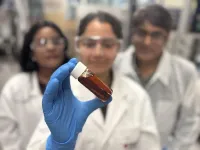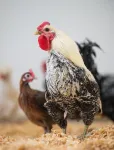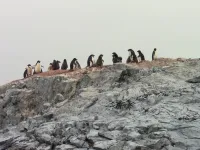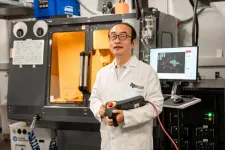(Press-News.org) 10 April 2025: The world’s first baby has been born following conception with a fully automated, digitally controlled intracytoplasmic sperm injection (ICSI) system. ICSI, developed and adopted into widespread use in the 1990s and now a routine method of assisted conception, achieves fertilisation by injecting a single sperm cell into the centre of a mature egg.
The details are reported today in the peer-review medical journal Reproductive Biomedicine Online.(1) The automated system was described and developed by a multidisciplinary team of specialists from Conceivable Life Sciences in New York and Guadalajara, Mexico, led by embryologist Dr Jacques Cohen, Chief Medical Officer Dr Alejandro Chavez-Badiola and Lead Engineer Professor Gerardo Mendizabal-Ruiz. Treatment was provided under review board oversight at Hope IVF Mexico (Guadalajara) as part of a pilot investigation into various processes of automation in the fertility laboratory.
The system was developed as a workstation automating each of the 23 steps of the standard ICSI procedure. These steps were operated independently either under artificial intelligence (AI) control or under the digital control of a remote operator. Presently, all the world’s ICSI procedures are performed manually by skilled embryologists operating microinjection systems. However, as studies have indicated, performance by the ICSI embryologist can vary significantly between individuals; now, says Dr Cohen, automation of the ICSI process ‘represents a transformative solution that promises to enhance precision, improve efficiency, and ensure consistent outcomes’ through reduced variability and work-related stress on human operators. He adds that the automated process might not only provide standardisation but will also improve egg survival and optimise timing of the injection.
AI has made significant advances in the IVF laboratory, with progress in sperm and egg selection. In the application of this latest system AI was used to position the sperm cell in the injection pipette and direct the microinjection itself within the egg.
‘With AI,’ explained Professor Mendizabal-Ruiz, ‘the system autonomously selects sperm and precisely immobolises its midsection with a laser ready for injection - executing this rapid, precise process with a level of accuracy beyond human capability.’
The successful birth was accomplished in a 40-year-old woman referred for treatment with donor eggs at Hope IVF Mexico in Guadalajara, following a previously unsuccessful IVF attempt which had produced only one mature egg and no embryos. In the study cycle, five eggs were assigned to fertilisation with automated ICSI, and three as controls with standard manual ICSI. The automated system was set up on site but thereafter remote operators, in the Guadalajara clinic and in New York, issued commands via a digital interface to perform each of the 23 microinjection steps for each egg (a total of 115 steps). Overall, the entire procedure took an average of 9 minutes 56 seconds per egg, a little longer than routine manual ICSI because of its experimental nature, but, said Professor Mendizabal-Ruiz, ‘we expect to reduce procedure time significantly’.
Four of the five injected eggs in the automated system achieved normal fertilisation and all three in the manual control group. One high quality embryo which progressed to the blastocyst stage in culture had been fertilised with the automated system under remote control in New York, 3700 km away. After this vitrified/thawed blastocyst was transferred in a subsequent cycle, a pregnancy was established which continued normally to delivery of a healthy male baby.
Dr Chavez-Badiola explains that the ICSI system described in this report supersedes all previous developments in ICSI by automating each single step of the microinjection procedure, with the additional steps of sperm handling and selection by AI.
Now, he adds, the system’s validity in a wider treatment application will depend on its safe performance in a study involving more cases. Nevertheless, he notes, the development so far, validated by a healthy live birth, marks a significant step towards full automation in the IVF laboratory. Here, automation has already become established practice in embryo culture, with incubators visualising embryos with time-lapse images and AI monitoring development and predicting outcomes. Automation is also being applied during the cryo-storage of eggs, sperm and embryos, as well as in sperm assessment and preparation procedures.
1. Mendizabal-Ruiz G, Chavez-Badiola A, Hernadez-Morale E, et al. A digitally controlled, remotely operated intracytoplasmic sperm injection system: The first live birth. Reprod Biomed Online 2025; doi:10.1016/j.rbmo.2025.104943
* For more information on this press release and the published paper, please contact:
Duncan Nicholas, RBM Online Development Editor
dev.editor@rbmonline.com
END
World’s first birth following conception with a fully automated remotely operated ICSI system
Automation poised to transform fertility treatment with greater efficiency and standardisation
2025-04-09
ELSE PRESS RELEASES FROM THIS DATE:
Girls’ education projects succeed when whole communities ‘live the change’ and carry it forward
2025-04-09
Education projects supporting marginalised girls in lower-income countries are more likely to achieve lasting transformations when they mobilise young women and their communities as “agents of change”, a new report indicates.
The recommendation comes from the latest evaluation of the Girls’ Education Challenge: a UK Government-supported initiative which has funded projects reaching more than 1.6 million girls. The University of Cambridge-led study finds that these projects initiated “virtuous cycles” of change – particularly by rooting themselves in communities and empowering young women to lead the way.
In ...
European bird declines linked to range of climatic conditions experienced
2025-04-09
New research suggests conservation efforts could more effectively identify and protect bird species at greatest risk from climate change by better understanding the range of specific conditions they need to thrive.
The study, led by the University of East Anglia (UEA), examined the relationship between the extent of the climatic conditions that species tolerate and in which populations can survive - known as climatic niche breadth - and their likelihood of declining in response to climate change.
For species inhabiting a similar area of geographic space, those able to tolerate ...
'Hidden galaxies' could be smoking gun in universe riddle
2025-04-09
Astronomers have peered back in time to find what looks like a population of 'hidden' galaxies that could hold the key to unlocking some of the universe's secrets.
If their existence is confirmed it would "effectively break current models of galaxy numbers and evolution".
The possible galaxies may also provide the missing piece of the puzzle for the energy generation in the universe in infrared light.
That's because their combined light would be enough to top-up the energy budget of the universe to the maximum we observe, effectively ...
Love songs in the sand: researchers listen in to Fiddler crab courtship
2025-04-09
UNDER EMBARGO UNTIL 00:01 BST THURSDAY 10 APRIL / 19:01 ET WEDNESDAY 9 APRIL 2025
For the first time, a study led by University of Oxford researchers has ‘listened in’ to the fascinating courtship displays of Fiddler crabs using geophones. The findings, published today in the Journal of Experimental Biology, provide new insights into how the animals communicate effectively on the noisy seashore.
For male fiddler crabs, vibrational signals are a crucial part of their courtship routines – produced by drumming the ground using their oversized claw, ...
Study suggests lean muscle mass loss can be minimized during weight loss therapy using newer incretin obesity drugs
2025-04-09
New research to be presented at this year’s European Congress on Obesity (ECO 2025, Malaga, Spain, 11-14 May) shows that patients using GLP-1 or combined GLP-1 / GIP receptor agonist therapy for weight loss experienced minimal lean muscle mass loss as they lost weight across 6 months of treatment. The study is by Dr Dinabel Peralta-Reich, Donald and Barbara Zucker School of Medicine at Hofstra/Northwell; Lenox Hill Hospital, Northwell Health, New York City, NY, USA, and Dr Alexandra Filingeri, New York Weight Wellness Medicine, New York City, NY, USA, and colleagues.
GLP-1 (glucagon-like peptide-1) receptor agonists, ...
Aussie tech helps make bio-oils for greener industrial applications
2025-04-09
Australian technology developed at RMIT University could enable more sustainable and cheaper production of bio-oils to replace petroleum-based products in electronic, construction and automotive applications.
The technology, known as PYROCOTM, uses high temperatures without oxygen to convert treated sewage (biosolids) into a carbon-rich product called biochar, which can act as a catalyst to produce phenol-rich bio-oil.
PYROCOTM has been developed by RMIT in collaboration with South East Water, Intelligent Water Networks and other water authorities over several years and is now being applied to several exciting circular economy applications.
The RMIT team's latest research in collaboration ...
Map of genetic regulation in chickens could help fight against bird flu
2025-04-09
An international team of researchers led by Professor Huaijun Zhou from the UC Davis Department of Animal Science has created the first-ever detailed map of how genes are regulated in chickens — a breakthrough that could help scientists breed birds that are more resistant to diseases like avian influenza.
The study, published April 8 in Nature Genetics, brings together a massive amount of genetic and epigenetic data of more than 100 chicken breeds from around the world. The team, which ...
Scientists map unprecedented detail of connections and visual perception in the mouse brain
2025-04-09
What: In a massive scientific effort funded by the National Institutes of Health (NIH), hundreds of researchers have helped to map the connections between hundreds of thousands of neurons in the mouse brain and then overlayed their firing patterns in response to visual stimuli. This breakthrough is a critical piece of foundational science to build toward understanding how our brains process visual information to reconstruct the images we see every day.
Information processing in the human brain occurs ...
Mapping mercury contamination in penguins of the Southern Ocean
2025-04-09
In 1962, when environmentalist and author Rachel Carson penned Silent Spring, alerting the world to the dangers of the pesticide DDT, it was the reproductive threat to birds – the bald eagle in particular – that spurred people to action.
Six decades later, Rutgers University–New Brunswick researchers are taking the measure of another global environmental pollutant by drawing parallels to the crisis Carson identified. This time, the pollutant is mercury, and the sentinels are penguins living in the farthest reaches of the Antarctic Peninsula.
“With mercury, there’s an analogy to DDT,” said John Reinfelder, a professor in the Department of Environmental Sciences ...
Engineer aims to make giant leap for welding materials on the moon
2025-04-09
Before humans can colonize the moon or Mars, scientists and engineers must first develop techniques for building permanent structures and pressurized habitats in harsh, thin-atmosphere and low-gravity environments.
Dr. Wei Li, an assistant professor of mechanical engineering in the Erik Jonsson School of Engineering and Computer Science at The University of Texas at Dallas, is developing a virtual lunar welding platform to troubleshoot assembling large structures in such conditions.
“As we try to return to the ...
LAST 30 PRESS RELEASES:
Sleeping in on weekends may help boost teens’ mental health
Study: Teens use cellphones for an hour a day at school
After more than two years of war, Palestinian children are hungry, denied education and “like the living dead”
The untold story of life with Prader-Willi syndrome - according to the siblings who live it
How the parasite that ‘gave up sex’ found more hosts – and why its victory won’t last
When is it time to jump? The boiling frog problem of AI use in physics education
Twitter data reveals partisan divide in understanding why pollen season's getting worse
AI is quick but risky for updating old software
Revolutionizing biosecurity: new multi-omics framework to transform invasive species management
From ancient herb to modern medicine: new review unveils the multi-targeted healing potential of Borago officinalis
Building a global scientific community: Biological Diversity Journal announces dual recruitment of Editorial Board and Youth Editorial Board members
Microbes that break down antibiotics help protect ecosystems under drug pollution
Smart biochar that remembers pollutants offers a new way to clean water and recycle biomass
Rice genes matter more than domestication in shaping plant microbiomes
Ticking time bomb: Some farmers report as many as 70 tick encounters over a 6-month period
Turning garden and crop waste into plastics
Scientists discover ‘platypus galaxies’ in the early universe
Seeing thyroid cancer in a new light: when AI meets label-free imaging in the operating room
Neutrophil-to-lymphocyte ratio may aid risk stratification in depressive disorder
2026 Seismological Society of America Annual Meeting
AI-powered ECG analysis offers promising path for early detection of chronic obstructive pulmonary disease, says Mount Sinai researchers
GIMM uncovers flaws in lab-grown heart cells and paves the way for improved treatments
Cracking the evolutionary code of sleep
Medications could help the aging brain cope with surgery, memory impairment
Back pain linked to worse sleep years later in men over 65, according to study
CDC urges ‘shared decision-making’ on some childhood vaccines; many unclear about what that means
New research finds that an ‘equal treatment’ approach to economic opportunity advertising can backfire
Researchers create shape-shifting, self-navigating microparticles
Science army mobilizes to map US soil microbiome
Researchers develop new tools to turn grain crops into biosensors
[Press-News.org] World’s first birth following conception with a fully automated remotely operated ICSI systemAutomation poised to transform fertility treatment with greater efficiency and standardisation









